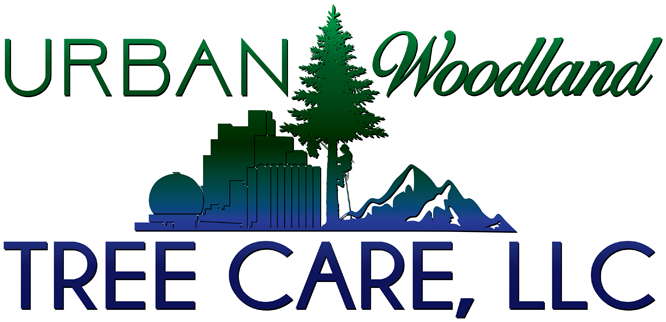Tree support systems provide supplemental support to leaders, individual branches, and/or entire trees. Cables, braces and guys provide supplemental support by limiting their movement. Urban Woodland Tree Care LLC have many years of experience installing these types of support set ups, and know what to look for when assessing your trees.
When a tree has a structural defect or condition that poses a high risk of failure it could result in injury or property damage. A support system can often reduce the risk. However, not all potential hazards can be mitigated. The tree needs to be thoroughly examined by an arborist or professional tree care company before installing any support system. Below are the most common structural defects with a high risk for failure:
- Codominant stem: Often referred to as a “V-crotch” or weak junction. Because of the lack of direct structural connections between codominant stems, they are structurally weaker compared to a single stem.
- Heavy or “overextended” branches: These are the branches that are unusually long for the tree species, are horizontal or downward growing, or have the majority of their foliage concentrated at the end of the branch. Breakage of these branches may occur at the junction with the stem, or they may split due to tension forces on the top and compression forces on the bottom of the branch.
- Weakly anchored tree: This condition exists when a tree is transplanted with a substandard root ball; has become uprooted; suffers from defective roots due to damage or decay; or has another condition that results in poor root anchorage.

Cable systems minimally consist of a set of anchors, a cable, and the appropriate means of termination or connecting cables to the anchor.
Pruning or removal should always be considered, as pruning may remove the structural defects and removal may be safest option. If a support system is still needed, there are a few options:
- Cabling: Cables restrict the distance that branches can move in relation to each other. Cable systems minimally consist of a set of anchors, a cable, and the appropriate means of termination or connecting cables to the anchor.
- Bracing: Brace rods are used to reduce the risk of two or more leaders spreading farther apart or moving sideways in relation to each other. They are also used to fasten together a junction or branch that is split apart.
- Guying: Guying is the installation of a cable between a tree and an external anchor to provide supplemental support and reduce tree movement. Established trees are rarely guyed, apart from a few cases such as trees that have been up-righted after being blown over or trees with serious root defects that cannot be removed due to historic importance or other reasons.
- Propping: Props are rigid structures built on the ground that support a branch or trunk. Props are used under branches or leaning trees to keep the branch off the ground or a structure or to provide clearance. Typically, props are used under branches that are nearly horizontal or growing downward.
One of our certified arborists will inspect your tree to determine whether it needs a support system, as well as determine which installation method is the best option. Support systems need to be inspected on occasion, to ensure that the system remains in good operating condition. It is important to understand that not only do trees need to be pruned for health and aesthetics, but that they be protected from failure, especially with the winds that the Washoe Valley is prone too.



VOTED BEST ARBORIST IN RENO

Certified Arborists

Quality Work

Licensed & Insured
We offer a 10% Senior and Veteran Discount.
- ISA Certified
- Owner Operated
- Licenced and Insured
- 24/7 Emergency Service
We are just a phone call away!
Weekdays
24 / 7
Weekends
24 / 7
URBAN WOODLAND TREE CARE
2000 Vassar St
PO Box 10764
Reno NV 89510
Nevada Licence:
#NV20171258445

